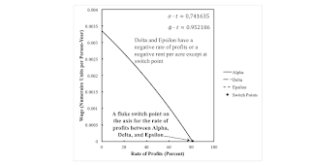This post draws attention to the existence of a vast web of existing organizations that, perhaps, operate partly outside and partly inside a capitalist logic. These standards organizations define technologies vital to keeping our society running. I think I would find it interesting for some scholar interested in council communism or syndicalism to look into these. The examples I list are perhaps idiosyncratic, out-of-date, and reflect my personal history with computing. Here is a list of...
Read More »On Sraffian Subsytems And Labor Values
1.0 Introduction I recently stumbled across McKiernan (2017), an Austrian response to Sraffa's book. This is a weird working paper. He works through Sraffa, with apparently no knowledge of all the textbooks explaining the book. McKiernan correctly notes that Sraffa provides little context about his points. And the mathematics is not always explicit. Naturally, McKiernan makes mistakes. If he ever revisits this, I think he would want to break it up into several papers. (Fabra (1991) is the...
Read More »Reminder: Wages, Employment Not Determined By The Supply And Demand Of Labor
1.0 Introduction Over a half-century ago, economists reached a consensus. The model in which employment and real wages are explained by the intersection of a downwards-sloping labor demand function and a supply function is incoherent, not even wrong. This incoherence was demonstrated under the assumptions of perfect competition and of firms that have adjusted their plant and other capital inputs. I do not know what Greg Mankiw and Jonathan Gruber are doing, but it certainly is not...
Read More »Sraffa I/141: Correspondence Beween Marguerite Kuczynski And Piero Sraffa
A Bad Reproduction Of An Engraving Of Quesnay In Kuczynski And MeekIntroduction This folder consists of: A 20 Sep. 1965 letter from Marguerite Kuczynski to Piero Sraffa. Sraffa’s handwritten annotation suggests his response is not in the archives. Handwritten notes made by Sraffa. An 18 Oct. 1965 letter from Marguerite Kuczynski to Piero Sraffa. A 25 Nov. 1965 handwritten draft letter from Piero Sraffa to Marguerite Kuczynski. An 18 Dec. 1965 letter from Marguerite Kuczynski to...
Read More »Elsewhere
INET has a collection of links in memory of Lance Taylor. Alex Thomas has a focused review of A Reflection on Sraffa’s Revolution in Economic Theory, which was edited by Ajit Sinha. John E. King has an overview in Jacobin, of Paul Sweezy's work. Ian Birchall, also in Jacobin, tells us about Daniel Guérin. I have read his Anarchism, but I am currently reading Iain McKay's Proudhon collection. Monthly Review reposts Ksenia Arapko's review of Michael Heinrich's How to Read Marx's...
Read More »Sraffa I/33: Alexander Gray to Gerald F. Shove
This is about Shove's review of The Socialist Tradition. Apparently Gray does not take those important in the development of economic thought seriously. Since Piero Sraffa is neither the recipient nor the sender, and the topic is not his work, maybe the editors of his collected works should not include this. 8, Abbotsford Park, Edinburgh. 10. 3rd November, 1946 Dear Shove, (If the fact that we occupied adjacent seats on the occasion of one of my rare visits to the Annual Meeting of...
Read More »Nonsense Taught At MIT
[embedded content]First Lecture For MIT Microeconomics I associate Jonathan Gruber with Obamacare. I think the Affordable Care Act is totally insufficient and a great advance. If politicians hire you to model the effects of some policy change, might you want to use, more or less, the most widely accepted techniques? I am also appreciative that I can watch this. When you are teaching, should you present claims in the most romantic way possible? "That is why I can teach you the entire...
Read More »Correspondence Between Rudiger Soltwedel And Piero Sraffa
This is C/294 in the Sraffa archives. Rudiger Soltwedel had his own letterhead. D 66 Saarbrucken 3, 28. Febr. 1968 Waldhausweg 7 Evangelisches Studentenheim Professor Piero Sraffa Trinity College Cambridge Dear Sir, I am student of economics at the University of Saarbrucken and I just began my finals work for my diploma. The topic of this study that Prof. E. Schmen formulated is your essay and its title is exactly that of your book: ‘Sraffa’s production of commodities by means...
Read More »1975 Letter From Krishna Bharadwaj To Piero Sraffa
This letter is an item removed from printed books in Sraffa's library. It is labeled Sraffa I/38 in the archives where I stumbled into it. 15th Oct, 75 Centre for Economic Studies, Nehru University, New Delhi 57 Dear Piero Sraffa, How are you? A lot of things have happened since my return in July to Delhi. Personally, my health was not too good for some time but has now stabilised somewhat. I had considerable teaching load this term and have had to devote a lot of time to...
Read More »On The Emergence of Multiple Cost-Minimizing Techniques
Figure 1: Wage Curves and Rent for an Example of Intensive Rent The analysis of the choice of technique has above always been based on the construction of a wage-rate of profits frontier. Given a technology in which requirements for use can be satisfied, prices of production for an eligible technique are uniquely determined by the given rate of profits. If the rate of profits is in a range where such prices are non-negative for at least one technique, one of the techniques is uniquely...
Read More » Robert Vienneau: Thoughts Economics
Robert Vienneau: Thoughts Economics


